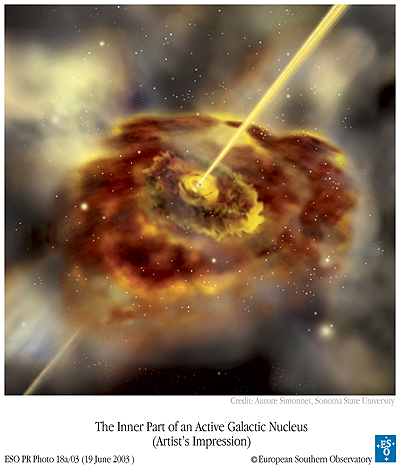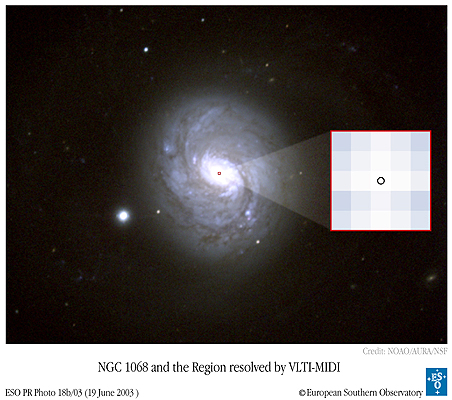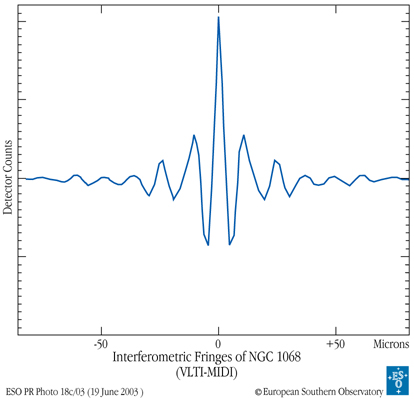| Press Release 03-06-27 | Press Releases 2003 |
A First Look at the Dusty Ring Around a Giant Black Hole
First detection by infrared interferometry of an extragalactic object
Active Galactic Nuclei (AGN) are one of the most energetic and mysterious phenomena in the universe. In some galaxies indeed, the core generates amounts of energy wich surpass those of normal galaxies, such as our Milky Way, by many orders of magnitude.
The central engine of these power stations is thought to be a supermassive black hole. Indirect lines of evidence have suggested that these massive black holes are enshrouded in a thick doughnut-shaped structure of gas and dust, wich astronomers call a »torus«. However, due to the limited sharpness of images that can be obtained with present telescopes in the 10 m range, such a torus has never been imaged to date.
However, the new and powerful VLT- Interferometer [1] – a mode of the ESO Very Large Telescope that combines light from at least two telescopes to obtain information on a very fine scale – should make possible such kind of observations. In fact, using the recently inaugurated MIDI instrument [2], which recently came into operation, a team of European astronomers [3] has now succeeded for the first time in resolving structures in the dusty torus of the prototype AGN, the famous galaxy NGC 1068. The structures have a size of roughly 0.03 arcsec, corresponding to about 10 light-years at the distance of the galaxy.
This important achievement shows that the VLT Interferometer, in conjunction with the MIDI instrument, is a valuable tool even in the study of objects outside our own Galaxy.
 |
Fig. 1: The inner part of an Active Galactic Nucleus (artist’s impression). Picture with higher resolution: 18a-03-normal.jpg (JPEG / RGB / 800x934 pxl / 508KB) |
|
 |
Fig. 2: NGC 1068 and the region resolved by VLTI-MIDI. Picture with higher resolution: 18b-03-normal.jpg (JPEG / RGB / 903x800 pxl / 652KB) |
|
 |
Fig. 3: Interferometric fringes of NGC 1068 obtained with VLTI-MIDI. Picture with higher resolution: 18c-03-normal.jpg (JPEG / RGB / 800x825 pxl / 276KB) |
|
Notes:
[1] More information about the VLTI and photos of many components of the facility are available at the VLTI Website, as well as in ESO PR 06/01 ("First Light" in March 2001and explanation of the interferometric measurements), ESO PR 23/01 (observations with two 8.2-m telescopes im October 2001), ESO PR 16/02 (observations with four 8.2-m telescopes in September 2002), ESO PR 11/03 (installation of the first MACAO adaptive optics unit in May 2003) and ESO PR 17/03.
[2] MIDI has been developed since 1997 at the Max Planck Institute for Astronomy, Heidelberg in collaboration with several Institutes in Germany, The Netherlands and France. For the "First Light" of MIDI see the MPIA press release Interferometry with MIDI at the ESO VLT telescopes.
[3] The observations were planned and carried out by an international team including Ch. Leinert, R. Köhler, K. Meisenheimer (MPI for Astronomy, Heidelberg), A. Richichi, M. Schöller, S. Morel, F. Paresce (ESO), H. Roettgering, W. Jaffe (Leiden), R. Waters (Amsterdam) und F. Malbet (Grenoble).
Contacts:
Dr. Ch. Leinert [MIDI]
Max Planck Institute for Astronomy
Heidelberg
Tel.: (+49) 06221 – 528 264
E-Mail: leinert@mpia.de
Dr. A. Richichi [ESO]
ESO Garching
Tel.: (+49) 089 – 3200 6803
E-Mail: arichich@eso.org
Dr. H. Roettgering [NEVEC]
Sterrewacht Leiden, Netherlands
Tel.: 003171 – 5275 851
E-Mail: rottgeri@strw.leidenuniv.nl
Further Information:
Dr. Jakob Staude
Max Planck Institute for Astronomy
Heidelberg
Tel.: (+49) 06221 – 528 229
E-Mail: staude@mpia.de
Press Releases 2003